Moog Muse Firmware Update 1.3: More chords, better performance & a review
We get hands on. Read on to find out if we were aMused...
Moog Music update the Muse firmware to v1.3! This brings system-wide latency reductions and improvements to velocity response, Diffusion Delay fidelity and Mod map behaviour.
All about Moog Muse
Moog Muse: Quick Facts
- 8-voice polyphony, unison and mono mode, bi-trimbral
- 2 analogue VCOs with saw, sine, square – HardSync and cross-FM included,
- 1 analogue noise generator
- 1 modulation VCO: either LFO or third VCO
- 2 VCFs: 1 HP/LP and 1 LP
- 2 LFOs, 1 pitch LFO, 2 ADSR envelope generators
- 61-key Fatar keyboard, glide and portamento
- Completely analogue signal path up to the effect: digital diffusion delay
- sequencer and arpeggiator
Update 1.3 – System Wide Optimizations
[December 17th, 2024] Moog Music announced today the next firmware update for the current analogue poly synth. It isn’t quite the feature-rich update that 1.2 was, but it addresses a number of issues and delivers some improvements too.
Moog say there are some significant system-wide optimizations that reduces latency which makes patch recall, editing and saving much more fluid. These in turn deliver benefits to the Diffusion Delay. There’s also velocity response improvements and a reduction of latency within the Mod Map.
Users can now perform updates using a flash drive with the USB-A port on the back of the Muse.

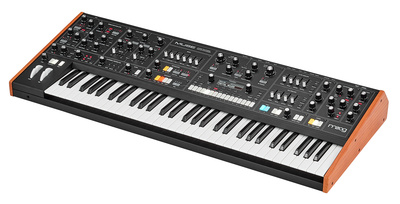
Update 1.2 with new features and bug fixes
[September 3, 2024] Moog has announced the new v1.2.0 firmware for the Moog Muse, which brings a number of interesting improvements, particularly in chord mode. With the update, users can now store up to eight different keymaps in the CHORD module, making it much easier to create and access chords. This feature allows 61 unique chords to be stored on the keyboard, allowing quick switching between different chord setups even when the unit is switched off.
Another highlight of the new firmware is the introduction of a MIDI panic function. Located as a soft button in the MIDI menu, it sends note-off messages to all voices. This helps to ensure smoother performance transitions and prevents potential glitches during live performances. A number of improvements have also been made to the user interface, particularly the clock setting menus, to improve speech intelligibility and overall system stability.
The v1.2.0 firmware update can be downloaded by all Muse owners from the Moog website and is easily installed in Muse’s disc mode. Detailed instructions on how to get the most out of the latest features can be found here on the Moog website.


Moog Muse – Review: Has Moog Finally Made a Great Poly?
[July 31, 2024] The worst-kept secret in synth-land is finally revealed. Can the Moog Muse live up to expectations, dispelling the myth that Moog can’t make decent poly synths?
The Moog Muse Backstory
Nearly six months have passed since we first caught sight of the Moog Muse, on stage at Superbowl LVIII in Las Vegas. At the time we were wondering if this was the cleverest leak of all time or just a huge mistake. Subsequent “leaks” from Synthfluencers confirmed it was neither. In what seemed a completely uncoordinated, scattergun series of glimpses, that which seemed to initially cause excitement, soon generated animosity.
The rumour mill kept on churning out speculation, both tame and wild, and an expected debut at Superbooth 2024 in Berlin never materialised. Well, not in public anyway. A group of people were quietly invited to a special event off-site in Berlin on the Friday of that week to get hands-on with both the Muse and Labyrinth.
Myself and a couple of other of my Gearnews colleagues were lucky enough to get some private time with the Muse, well ahead of the evening event, and it was here that we finally got to see and hear what the fuss was all about. Could Moog, under its new stewardship with inMusic, finally crack that nut they have struggled to for so long and answer the following question…

Can Moog Make a Good Polyphonic Synth?
Moog is like the esteemed Italian car manufacturer, FIAT. For decades, it has often be said that FIAT just cannot make large cars. They excel at brilliant super-minis like the 500, Uno, Punto and Panda. But ask them to come up with a family saloon and they just seem to fail every time. So it seems to be with Moog and polyphonic synths. Every attempt falls foul of something, be it the Polymoog, the Memorymoog or, more recently, the Moog One.
Now, I’m sure that right now, there are Moog aficionados screaming at their screens at the mere suggestion that their beloved polyphonic Moog synth is somehow deeply flawed. It seems the mere mention that the Moog One might not have been the greatest synth ever built gets a small number of enthusiasts foaming at the mouth!
But when compared to other similar instruments and manufacturers, it would appear that over the last few decades, Moog seems to have a polyphonic monkey on its back. Quite why this is is anybody’s guess, and so the prospect of another attempt by the Asheville legends fills one with both excitement and trepidation in equal amounts.
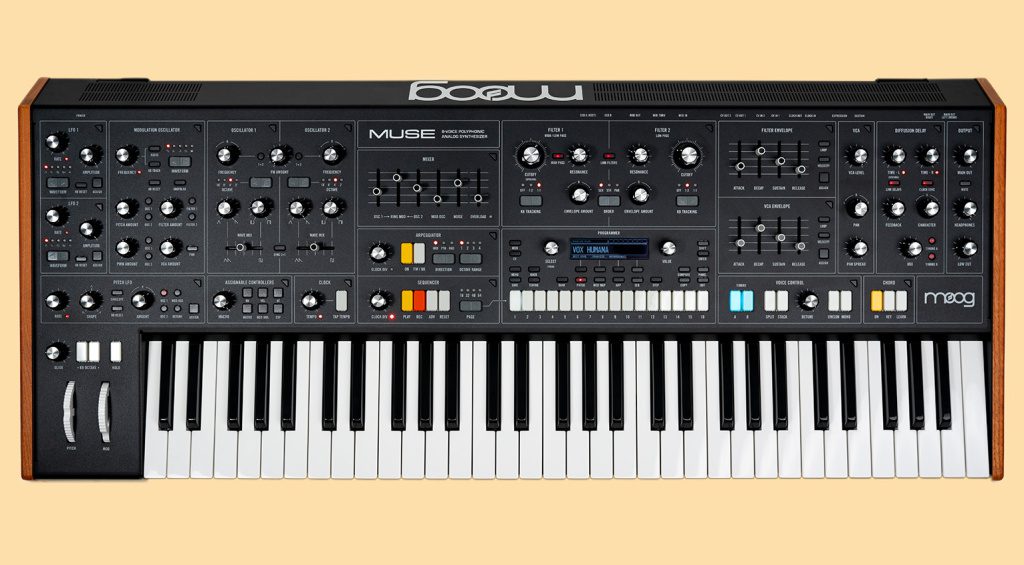
First Impressions of the Moog Muse
At first glance, the Moog Muse does not have the grandiose and imposing physicality of its predecessor. Whilst it is unquestionably a Moog product, it looks almost pedestrian in terms of its visual design. It’s a 61-key affair with a suitably busy user interface that draws inspiration from Moog Modular front panels as much as it does other poly keyboards. Those Polymoog-style fader caps on the mixer and envelope generators are obvious nods to its lineage.
The red, white and yellow chiclet buttons evoke memories of both Roland & Yamaha UI’s of the past but, overall, the moment you stand before the Muse, you feel at home. This feeling is further enforced by the angles used in the chassis and the wooden end cheeks. This is a design that knows its ancestors well but also serves its contemporary audience.
The Moog Muse is an 8-voice polyphonic analog synthesizer. It doesn’t profess to be anything more and its design certainly reinforces that. I instantly took to it and was finding my way around it within seconds. As always, I like to judge a synth initially by seeing how easy it is to use without reference to a manual. The Muse passed this test with flying colours, which is just as well as there was no user manual to hand!

Inside the Moog Muse
So what’s inside the Muse? Before we start, I think it is worth mentioning what drove the design of the Muse. The Moog Muse is, for want of a better phrase, a compilation of Moog’s greatest hits. They have taken some of the best bits of their previous instruments, both sonically and visually, spanning their entire existence, and built a polyphonic synth that takes those ingredients and cooks up something new with them.
Muse contains two VCOs that offer triangle, sawtooth and pulse waveforms. The guy from Moog I spoke to said the design of these was inspired by the oscillators used in the Voyager. The triangle and sawtooth can be blended, if desired, and the pulse wave width is variable. These can then be blended, per oscillator, using the wave mix control. Both have 2′, 4′, 8′ and 16′ octave settings and can be routed to frequency modulate each other. They can also be hard-synced.
There’s a third oscillator called the modulation oscillator with multiple waveforms that can be applied in several different ways. It’s a hugely flexible tool that can function as a third oscillator in its own right, or as a modulation source. There are also two standard LFOs as well as a separate pitch LFO, so it is safe to say your modulation options are more than covered.
And, as expected, there is an analog noise generator. All of these oscillators are fed through to the mixer, along with the noise and ring mod (possibly a version of the Bode design?) and there is also an overload control for really beefing that sound up.
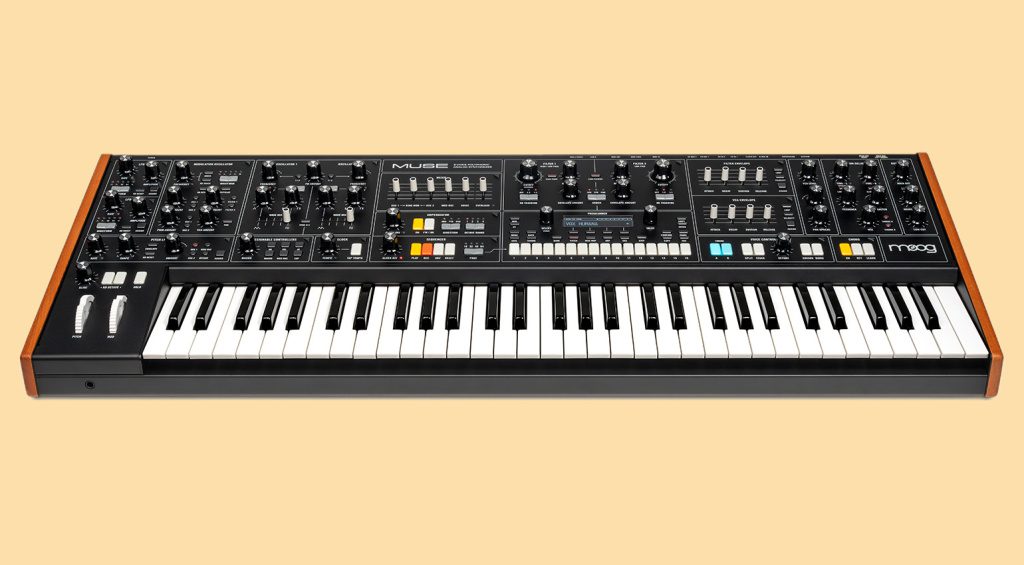
The filter section, based on the Moog 904-A module, contains two transistor ladder-style filters, one with high and low pass and the other just low pass. They can be routed in series or parallel and can also be used in stereo. The two envelope generators, one for the filter, the other for the VCA, are both ADSR types with looping and velocity. That VCA, by the way, is based on the Moog 902 module.
As you will expect, the whole signal path is fully analog until, that is, it reaches the diffusion delay effect. This is a digital effect but it can by entirely bypassed to maintain full analog authenticity. I actually really liked the diffusion delay and I’m pretty sure most analog purists won’t mind what it does with the Muse sound.
It does enough to lift the Muse above certain contemporaries and give it that sheen that makes the Muse really delightful to listen to. I was instantly reminded of what the chorus unit did in the Juno range of synths. Simple, yet effective.
Made For Performance
Performance wise, the Muse comes with everything you would expect from a synth of this calibre and price (more on that later). Muse is a bi-timbral synth that can split or stack those two elements. There’s also a unison mode that really rattled the speakers in the studio, as well as a mono mode.
The arpeggiator operates per timbre which is very cool and has enough settings to make it instantly useable and musical. There’s also a 64-step sequencer which utilises the 16 buttons in the programmer to make it easy to program in step time as well as see what is going on. A chord feature allows you to select notes at different intervals to form a single-key chord function and there are glide and hold functions too.
Macro functionality seems to be increasingly common these days and such a feature exists on the Muse. The programmer section features a small but clear screen that is mainly used for patch name display but does feature soft key assignments to access a few deeper features. Fear ye not, though, as Muse is a truly knob-per-function synth. That said, there is a small, triangular button in the top right-hand corner of all the sections that delivers some finer details and adjustments on the menu screen.

On the rear, connectivity contains all the usual suspects. Full-size MIDI, two pairs of CV in/outs, clock in and out, expression and sustain pedal ports and two USB ports (one A, for system and data back up, and one B for connecting to computers and class-compliant devices). There’s also a pair of audio outs and the headphone socket is on the front, where it should be.
As for the keybed, it is a really nice 61-note Fatar affair with velocity and channel aftertouch. I have to say, I was slightly disappointed that it wasn’t polyphonic aftertouch, such is the trend these days. I’m sure there are reasons for this and I wouldn’t be surprised if Moog added something like last-note aftertouch, the way Arturia did with the PolyBrute 6.
Aftertouch, both channel and poly, can be an acquired taste for some. Some people seem to dislike it with a passion and are seemingly unaware that you can turn such things off. That said, polyphonic aftertouch doesn’t suit every synth. But it would’ve been nice to have the choice.
The Sound of the Moog Muse
Well, that’s the specs covered. How does the Muse play and sound? My first experience of the sound of the Muse was given to me by my dear friend, Lisa Bella Donna. Lisa is a stunning virtuoso keyboard player and in her hands, it sounded magnificent. But I wanted to play it for myself and, with huge thanks to Moog, I was afforded the opportunity to have my wicked way with her. The Muse, that is, not Lisa!
My first impression was that this was, sonically, unmistakably a Moog synthesizer. That Moog sound is undeniable and it just oozes class and style. It is familiar, welcoming and reassuring. The Muse exuded it instantly. But the first thing that really struck me was that, unlike the Moog One which was very much a sound explorer’s synth, the Muse is very much a performance instrument.
That’s not to say that you won’t get drawn into its superb “best of Moog” architecture, but it really does grab you and make you want to play. And I believe that has been Moog’s intention all along. We first saw it on stage, in front of a TV audience of some 115,000,000 people. The Muse is going to be right at home in such venues. And at only 14.5kg, it’s brilliant for gigging.
The Muse occupies a visual and sonic space that is similar to the analogue greats of the 80s. The Jupiter 8, the Memorymoog, the Polysix, the Prophet 5 and the Oberheim OB-X. Moog hasn’t tried reinventing the wheel here, but they also haven’t phoned this one in. The Muse doesn’t necessarily break new ground so much as it fills that affordable Moog-shaped poly hole that has existed for such a long time.
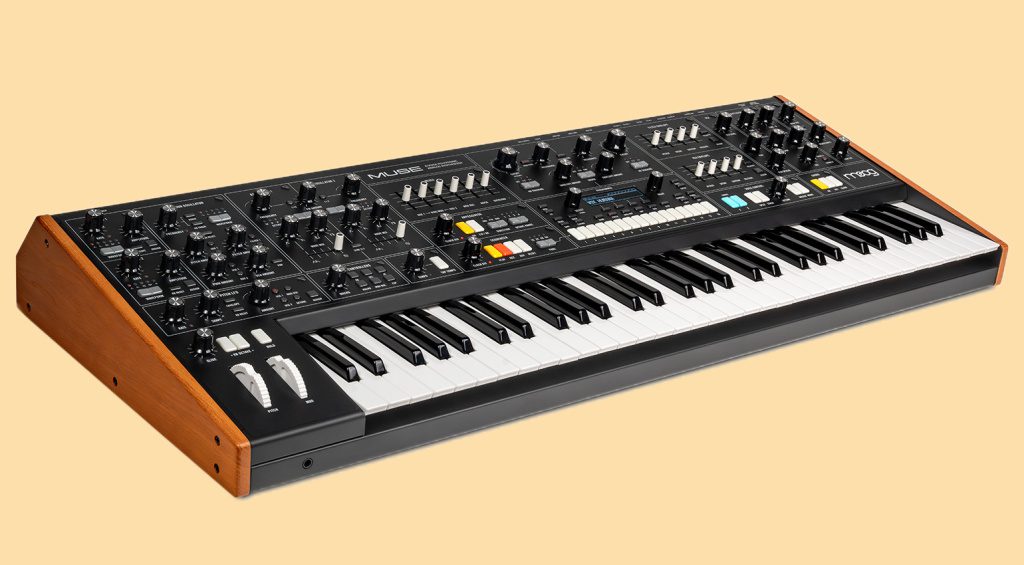
The Moog Muse is a synth that would look at home on the stages of the greatest bands and artists of the 80s. What I mean by that is that the look and sound of this synth are almost timeless. Just like a Jupiter 8 still looks amazing today, the Muse has that quality in abundance too.
If you told someone outside of our synthy bubble that the Muse was an 80s synth and a retro classic, they’d almost certainly believe you. The name, the look and, most importantly, the sound, have been missing for decades in the world of analog polys and boy does it feel good for it to be back.
Scrolling though the presets, there are bucketloads of sounds that you would expect to have in such an instrument, but some of the sound designers have really gone to town with this and come up with sounds you may not attribute to an analog poly by Moog.
Muse Vs. The Rest
Isn’t it fantastic that, in 2024, I am able to write a review of a new polyphonic analog synth and have a number of brilliant current polyphonic analog synths to compare it to? We live in heady times, indeed! Behringer, KORG, Sequential Circuits, Oberheim, Arturia… we are spoiled for choice. And to be a music tech journalist reviewing a new Moog analog poly is quite an honour.
So how does the Muse stand up to this competition? When you put this up against those other, contemporary analog polyphonic synths, it easily stands shoulder to shoulder with many. Against some, it delivers WAY more bang for your buck. What it lacks in some areas, it more than makes up for in others. Moog has priced this aggressively and it will, without question, threaten some existing instruments market share. It will also lay down a significant marker for those to come.
As I said earlier, I am surprised that Moog swerved the whole polyphonic aftertouch thing, given that it is the ‘feature du jour’ these days. When you have competition at both ends of the analog poly market delivering polyAT as standard, it seems odd to leave it out. I could also say the same for Sequential and Oberheim, so it’s not just a Moog thing.
If you are tempted to ask how the build quality is in the new, inMusic era of the brand, any concerns you might have can be brushed aside. The Moog Muse is a solid, robust and well-put-together unit. As with all Moog synths, it is assembled in Asheville and bears all the quality manufacturing hallmarks of its predecessors.
The Bottom Line
If pushed, I would say that this represents better value for money than the Sequential Prophet 5 or Oberheim OB-X8. It falls a little short of Arturia’s PolyBrute 12 which I still believe is a modern classic that will live on in synth folklore as much as, if not more than, the Yamaha CS-80. That said, the Moog Muse represents a reset and restart in their rich and varied story with polyphonic synthesizers. From this position, Moog can continue to build superb instruments at both ends of the price scale. Polyphonic Moogs have a new ground zero.
Moog Muse: pros and cons
Pro
- Polyphonic Moog without the quirks
- Mighty sound, captures the ‘Moog’ character
- Every function can be controlled via a controller, making it perfect for live performance
- Diffusion Delay allows completely new sounds
- Completely analogue signal path
Cons
- No polyphonic aftertouch
The Moog Muse is available to order now for $3,199.00 / £3,066.00 / 3,499.00€.


*This post contains affiliate links and/or widgets. When you buy a product via our affiliate partner, we receive a small commission that helps support what we do. Don’t worry, you pay the same price. Thanks for your support!
Previous updates to this story by Adam Douglas…
[July 16 2024] Somebody jumped the gun. A retailer in Norway accidentally went live with the Moog Muse. The page has since been taken down but not before we got pics, specs and a price. Boy, is this thing fully loaded.

The eight-voice polyphonic Moog Muse has a lot. It’s got three oscillators, two with PWM and a selectable triangle/sawtooth mix, with one doubling as modulation. However, it’s not just an LFO but a ‘modulation oscillator’ with selectable waveforms (sine, sawtooth, reverse sawtooth, square, noise), an audio range switch, a unipolar switch, pitch modulation, filter modulation, pulse width modulation, VCA modulation and a panning switch. Yes, like the Matriarch, the Muse is stereo.
Moving on, there’s an analog mixer that allows you to combine the three oscillators plus ring mod, analog white noise and overload amount.
Moog Muse got Ladder filters – two of them – with one handling lowpass and the other both lowpass and highpass duties. You can link them, run them in parallel or series or… stereo.
Let’s keep going. There are two multi-trig looping ADSR envelopes with variable curves per stage; two LFOs plus a dedicated pitch LFO, and a comprehensive VCA with volume per timbre, pan position per timbre and pan spread per timbre.
Is there more? There’s more. Moog Muse got a Diffusion Delay, a digital configurable stereo multi-tap delay, plus an arpeggiator, 64-step sequencer, chord memory and modulation mapping with 16 modulation slots per timbre per patch with controllers and mathematical transform functions. Note that the Muse is 100% analog aside from the delay; you can choose to bypass the delay if you wish.
Connectivity includes DIN MIDI in/out/thru and MIDI over USB, CV and analog clock in and out as well as headphones and quarter-inch stereo outs.
Price of Moog Muse was listed as 47380 kroner which translates to around $4300 USD. No word yet on availability.
Keep in mind none of this is confirmed by Moog but this is all very exciting. And I know the cylindrical caps on the sliders are meant to recall the Polymoog but I used to own a Realistic Concertmate MG-1 and it had them too so that’s what I’m remembering and it’s got me really excited.
Moog Muse?
[April 7 2024] The Mirror is now the Moog Muse. Synth-loving music producer Mike Dean shared an image on his Instagram Stories showing the mixer section of what seems to be a new eight-voice polyphonic Moog. It clearly says Muse and not Mirror. This would be in keeping with Moog’s female-centric naming scheme, particularly if the new instrument really is a polyphonic synth based on Matriarch architecture, as rumoured.

Looking at the picture, which seems to show the mixer section of the panel, we can see that it has two oscillators, ring modulation, an oscillator modulation slider, noise and something tantalizingly called “Overload.” Below the mixer, there appears to be an arpeggiator. The shape and styling of the sliders are very Polymoog-esque.
Keep in mind that nothing about this release is confirmed and it could all come to nothing. But an affordable polyphonic Moog is certainly something to get excited about – even just the possibility of one.
(Original article): With all the hoo-har around Moog and the InMusic buyout, it’s great to get positively excited about the possibility of a new Moog synth. Apparently, it was seen as part of the huge array of synths that were on stage for Usher’s halftime show. I’m not sure about that. There are certainly a lot of recognisable Moog products on stage, but you’ve got to have a keen eye to spot a previously unreleased one.
Mystery Mirror Moog
Regardless, Andrew Huang has thrown embargoes to the wind by posting a selfie of him sitting in front of an unknown Moog synth. What could it be? Andrew isn’t telling us – yet. Reports from the ether suggest that it will be called the Moog Mirror, it will have 8-voices and is based on Matriarch architecture.
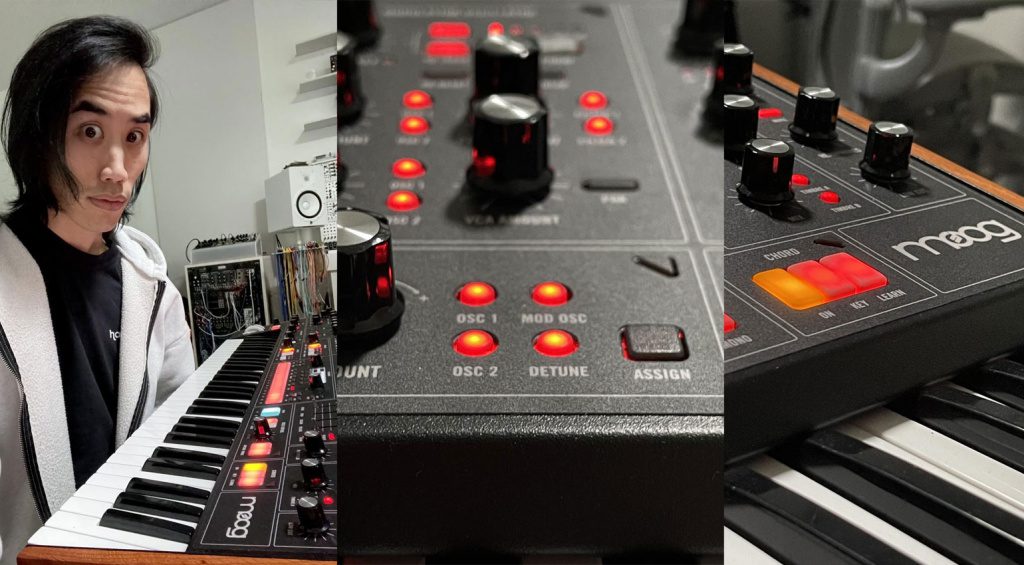
What we can see is a bunch of chewably lit, lozenge-sized buttons, a close-up of some classic Moog knobs and metal panelling and a five-octave keyboard with wooden cheeks. It looks very smart. It doesn’t look like something as high-end as a Moog One or MemoryMoog, in fact for me it reflects more of a Prophet-5 sort of vibe. There is a screen you can just see, and those buttons are likely to be preset selections. There’s a good bunch of controls, but not a crazy amount. It has two oscillators, a Chord mode and at least a Unison mode, all of which point to some polyphony.

According to commentators, we’re supposed to be looking at the synth named Mirror underneath the Matriarch on the left. The synth that looks very much like a Roland Jupiter-X. I’m sure these things will become clear.
This image just appeared on Facebook from Sounds-for-Synths.com that is positioned very differently from the one we’re supposed to be looking at. I think this is the synth on the far right, just above the corner.
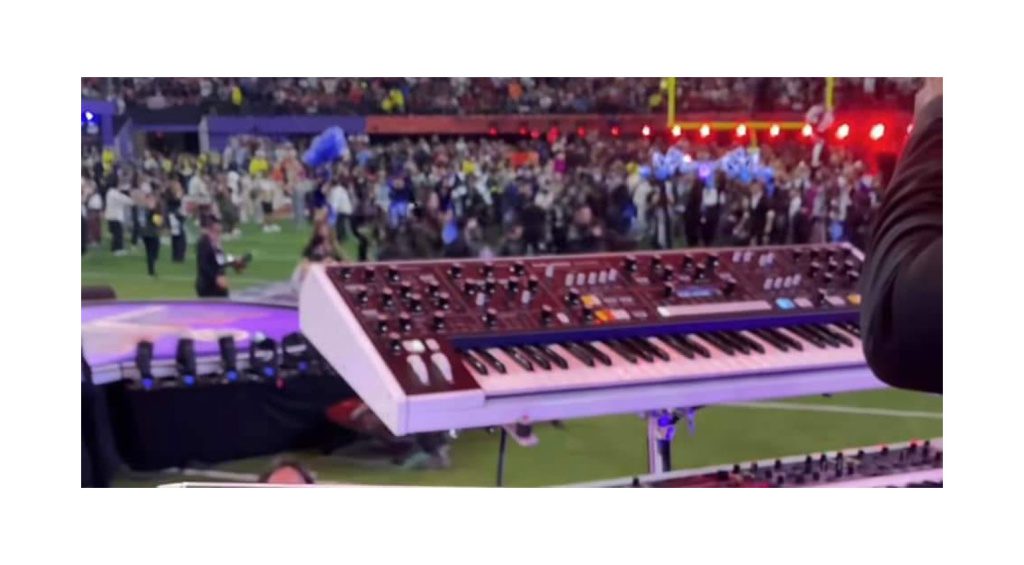
What’s coming?
Could Moog be returning to the market with a lovely new polysynth named Mirror? And could it possibly be a more mid-market machine rather than an aspirational premium instrument that only the few can afford? Maybe that’s the hope that InMusic brings to the table – an affordable poly-Moog.
The rumours, guesswork, and confident declarations from synth-heads will be abounding on social media until we get the official information. It’s certainly more exciting than who won the Football.
26 responses to “Moog Muse Firmware Update 1.3: More chords, better performance & a review”
 4,1 / 5,0 |
4,1 / 5,0 | 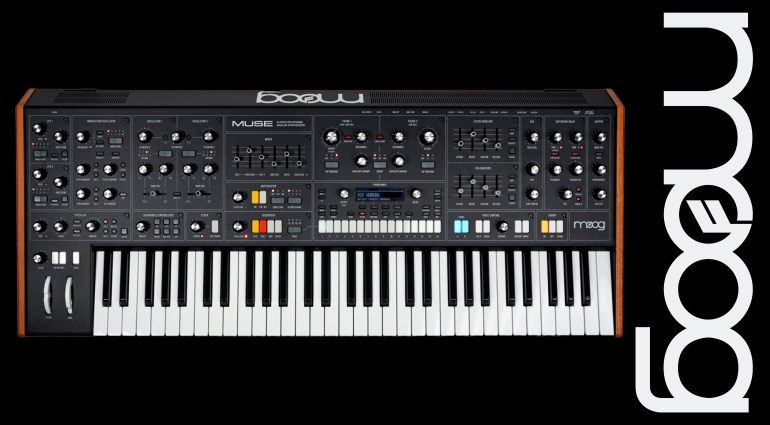
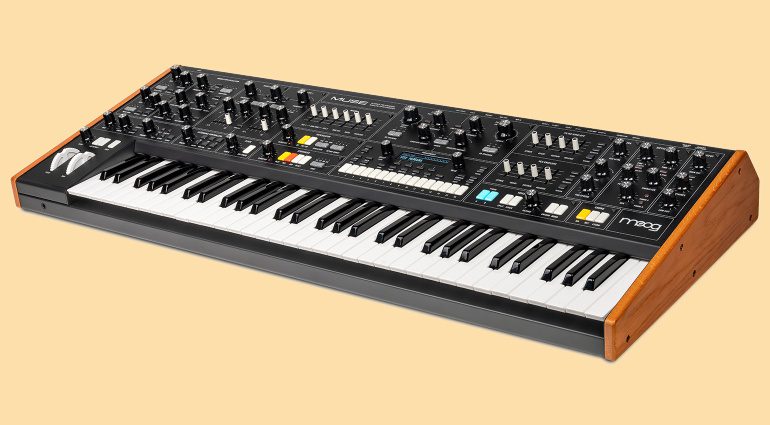
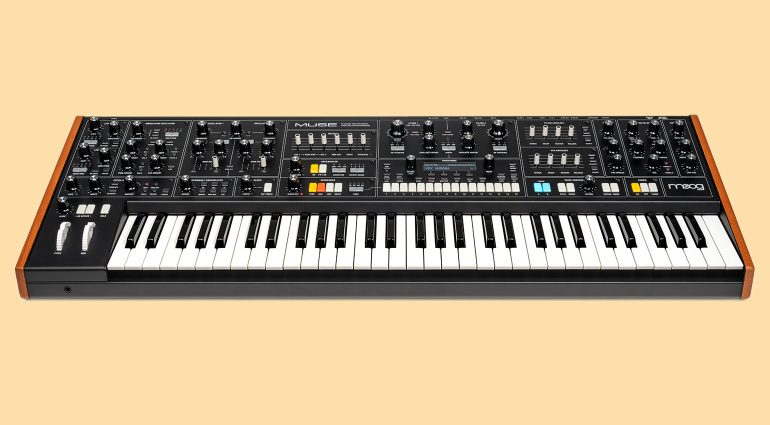













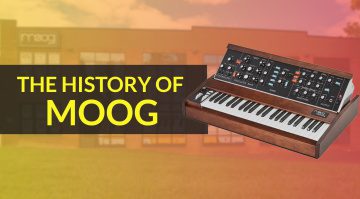
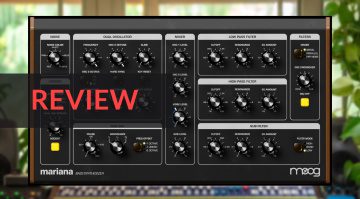
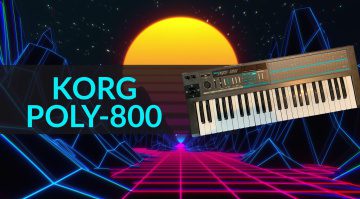

is it good for wooly bully watch it now
In keeping with the Mother, Grandmother naming theme, this polysynth will be called the “Moog Bridge Club”
(i kid)
that white Matriarch is pretty baller
Who cares?
Andrew Huang represents everything wrong with ‘synth culture’. A talentless shill
it’s fun to make noise with any moog synthesizers…..I know nothing about playing but anyone can sound great with a moog mini model d
I couldn’t disagree with you more.
Red buttons comes from KORG (M1) !
the funny fact that it is only the Energy cable connected… no audio cable… all fake?
Tutti frutti buttons! how tasteless and sugar free!
To hear and see the new synth being played check out “Behind The Super Bowl LVIII Halftime Show with Moog and the Avila Brothers” from 5m57s to 6m18s. I think this is the first teaser to be released by Moog.
Moog Poly? I could be wrong but I suspect they’re ripping off Behringer’s Poly D
lets make a teaser promotion by releasing unfocused pictures, yea thats brilliant marketing
they should have made it semi-modular.
looks good. A haphazard guess, is that this will replace the discontinued moog one (which was tri-timbral in both incarnations ), & there may be a 12 or 16 voice model &/ or the ability to add extra voices as and when/ if you can pony up the cash.
Dosen’t Norway list their prices incl 25% tax? So in USD before tax should be something like 3500?
But…..Red Buttons was in “The Poseidon Adventure”!
Maybe about £3000 then? Not too bad for all the stuff it has. Looks a bit more moveable than the Moog One. How many presets? When you say 20 mod slots per timbre, is it bi or tri timbral? That’d be 6 or 9 osc. Fatter than everything, other than the Moog one, and my wife.
Anyone who saw that price who knows if 47380 kroner (crowns) is incl. or excl. VAT?
Looks boring. Nothing new bar the ‘diffusion delay’ that’s unlikely to be discernible from a freeware VST in a mix.
@ Mark Dolan – you are absolutely right about Huang and his cronies, it’s just embarrassing. However a significant number of people buying this stuff are hugely influenced by such clowns, it’s the Pokemon thing (Gotta Catch Em All) – none are actually musicians. This in turn encourages the release of more of the same old garbage.. sad
– you are absolutely right about Huang and his cronies, it’s just embarrassing. However a significant number of people buying this stuff are hugely influenced by such clowns, it’s the Pokemon thing (Gotta Catch Em All) – none are actually musicians. This in turn encourages the release of more of the same old garbage.. sad
Thank God I’m not the only one noticing this. I’ve been playing and composing for 40 years and when I ran into these YouTube synth reviewers, I kept wondering why they only noodled and never really played. I finally found out why. Most of them can’t. They are just personalities. My first clue was looking at their fingers and almost never using their left hand for anything. Very sad.
You are absolutely right, but their meagre playing skills utterly outline their appalling lack of basic understanding of sound design or how synthesisers work.
The guitar pedal influencers are even worse, yet morons lap it up.
Seems Arturia is the new moog
polybrute 12 , matrixbrute
It’s probably a great overall analog synth. Good feature set. Okay sound. If you’re going to have just one hardware synth, this might make the list.
Hey Moog,
How about an update for the Moog One? There are still a few bugs there and some things you promised in that past. Or do you abandon updates the moment you stop selling synth models?
*gnarls teeth bitterly*
‘ Or do you abandon updates the moment you stop selling synth models?’
– it’s Moog, so usually they abandon updates a considerable time BEFORE they stop selling it!
Tried one (demo not for sale) yesterday. I personally didn’t like the sound of it. The interface is good, and granted the sound is raw, but it did’nt seem to have that smooth texture I was expecting. Also very expensive.